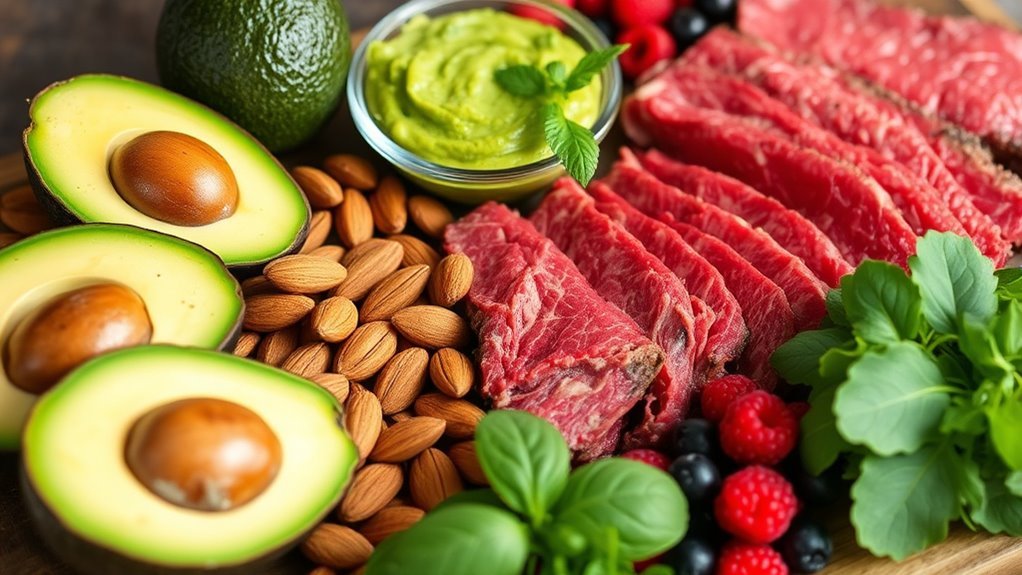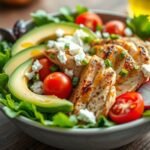Keto foods focus on low-carb, high-fat, and moderate-protein options. You’ll want to include healthy fats like avocados and olive oil, lean proteins such as chicken and fish, and low-carb vegetables like spinach and cauliflower. These foods help your body burn fat for energy. It’s also essential to avoid high-carb items like grains and sugary snacks. If you’re curious about meal planning and snack ideas that fit this lifestyle, there’s more to explore.
Understanding the Ketogenic Diet
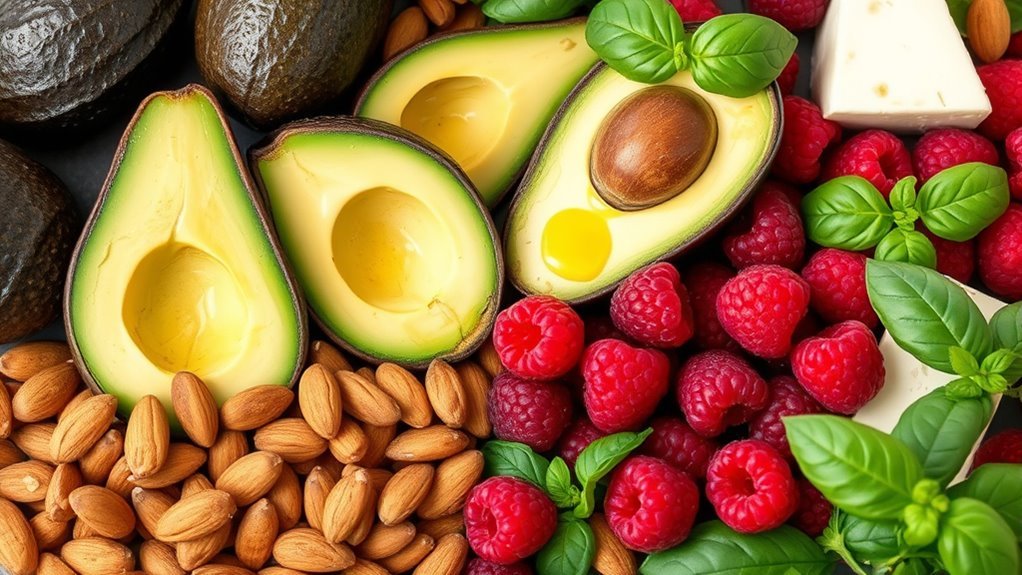
When you plunge into the ketogenic diet, you’ll discover it’s more than just a trendy eating plan; it’s an all-encompassing approach to nutrition that emphasizes high-fat, moderate-protein, and low-carbohydrate intake. Many keto diet misconceptions suggest it’s all about bacon and cheese, but it’s actually about nourishing your body with healthy fats and nutrient-dense foods. Embracing this lifestyle can lead to numerous ketogenic eating benefits, including weight loss, improved mental clarity, and stable energy levels. By shifting your body into ketosis, you’re teaching it to burn fat for fuel instead of carbohydrates. This freedom from traditional dietary constraints can be empowering, allowing you to enjoy a diverse range of foods while achieving your health goals.
Key Components of Keto Foods
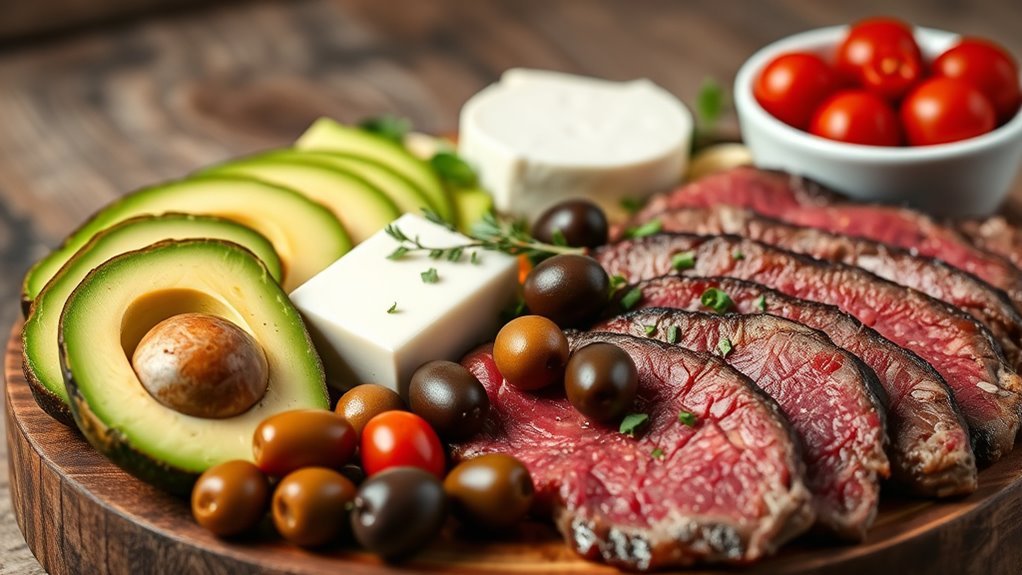
To successfully embrace the ketogenic diet, understanding the key components of keto foods is essential. Primarily, you’ll want to focus on low-carb, high-fat food groups that help your body enter ketosis. This means prioritizing vegetables like leafy greens, healthy proteins such as fish and poultry, and high-quality fats like avocados and nuts.
Meal prep is vital for staying on track, as it allows you to plan and prepare meals in advance, ensuring you have keto-friendly options readily available. By incorporating these food groups into your meal prep routine, you can enjoy a variety of satisfying meals, all while maintaining your low-carb lifestyle. Remember, balance is key to making your keto journey enjoyable and sustainable.
Healthy Fats to Include
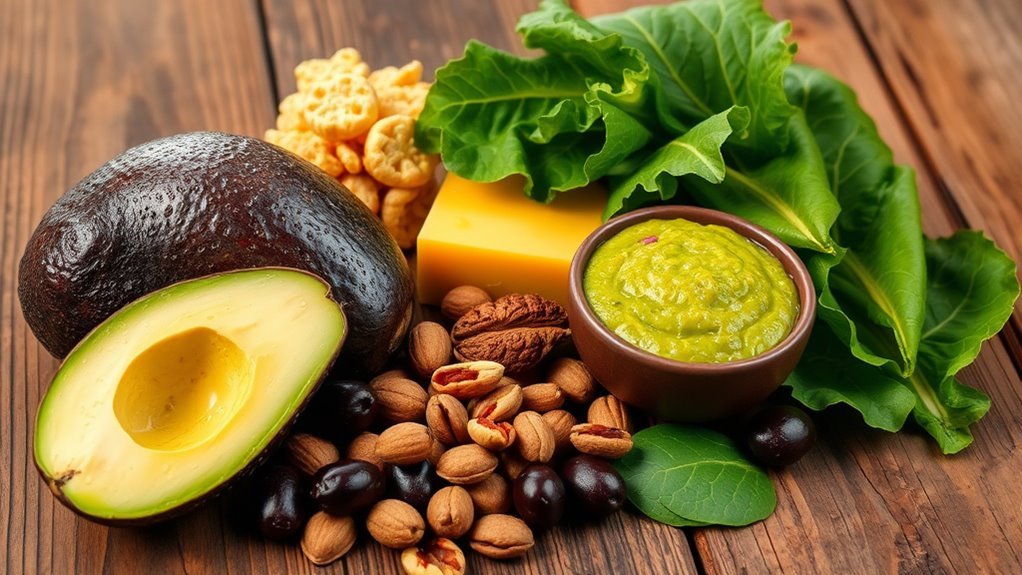
When you’re following a keto diet, incorporating healthy fats is essential for both energy and overall health. Foods like avocado and olive oil provide beneficial monounsaturated fats, while nuts and seeds offer a great source of omega-3 fatty acids and fiber. Including these options not only enhances flavor but also supports your nutritional goals effectively.
Avocado and Olive Oil
Avocado and olive oil stand out as two of the healthiest fats to include in a ketogenic diet. These foods not only provide essential nutrients but also support your low-carb lifestyle.
Consider the following benefits of incorporating them into your meals:
- Avocado varieties: From Hass to Fuerte, each type offers unique flavors and textures.
- Healthy monounsaturated fats: Both avocado and olive oil are rich in these beneficial fats, promoting heart health.
- Antioxidant properties: Olive oil is packed with antioxidants, which can help reduce inflammation.
- Versatile cooking options: Use olive oil for sautéing or drizzle it on salads, while avocados make a creamy addition to smoothies.
Embracing these healthy fats can enhance your well-being while you enjoy delicious meals.
Nuts and Seeds Options
Nuts and seeds are excellent sources of healthy fats that can greatly enhance your ketogenic diet. Incorporating walnuts can provide significant health benefits, including omega-3 fatty acids, which promote heart health and reduce inflammation. Plus, their high fiber content helps keep you feeling full longer. Chia seeds are another fantastic option; they’re packed with nutrients and can absorb liquid, forming a gel-like substance that aids digestion. These tiny seeds also provide protein and essential minerals, making them a great addition to smoothies or salads. By including a variety of nuts and seeds in your meals, you’ll enjoy not only a diverse range of flavors but also the freedom to nourish your body effectively while staying in ketosis.
Low-Carb Vegetables
When following a keto diet, incorporating low-carb vegetables can greatly enhance your meals while supporting your nutritional needs. You’ll find that options like spinach, zucchini, and cauliflower not only have minimal carbs but also provide essential vitamins and minerals. Plus, with some simple cooking tips, these veggies can be flavorful additions to your keto lifestyle.
Best Low-Carb Options
If you’re following a ketogenic diet, incorporating low-carb vegetables is essential for maintaining proper nutrition while keeping your carbohydrate intake in check. These veggies not only fit well into keto meal prepping but also add flavor and texture to your meals. Here are some of the best low-carb options you should consider:
- Spinach
- Zucchini
- Cauliflower
- Broccoli
These vegetables are versatile and can be used in everything from salads to low carb desserts. They provide essential vitamins and minerals while keeping your carb count low. By including these options in your diet, you can enjoy a variety of dishes without sacrificing your keto goals. Embrace the freedom of choice while fueling your body with nutritious foods!
Nutritional Benefits Explained
Incorporating low-carb vegetables into your ketogenic diet not only supports your carb limits but also offers a wealth of nutritional benefits. These veggies are packed with essential vitamins and minerals, making them an essential part of any keto food strategy. They help maintain energy levels and support overall health while keeping your carb intake low.
| Low-Carb Vegetable | Nutritional Value (per 100g) |
|---|---|
| Spinach | 23 calories, 2.9g net carbs |
| Broccoli | 34 calories, 4g net carbs |
| Zucchini | 17 calories, 3.1g net carbs |
Cooking Tips and Ideas
Cooking low-carb vegetables can be a game-changer for your ketogenic meals, as they not only add flavor but also enhance the nutritional profile of your dishes. Here are some tips for keto cooking with low-carb veggies that’ll make your meal prep easier and more enjoyable:
- Roast for flavor: Roasting brings out the natural sweetness and depth of flavor in vegetables like zucchini and bell peppers.
- Experiment with spices: Use herbs and spices to elevate taste without adding carbs; think garlic, cumin, or paprika.
- Incorporate healthy fats: Sauté in olive oil or butter to keep your meals in line with keto principles.
- Mix and match: Combine different vegetables for texture and visual appeal, making your dishes more enticing.
Enjoy the freedom of creativity in your keto cooking!
Protein Sources for a Keto Diet
While many diets emphasize carbohydrates, a keto diet thrives on high-fat and moderate-protein foods that can support your body’s shift into ketosis. When choosing protein sources, lean meats like chicken, turkey, and beef are excellent options, as they provide essential amino acids without unnecessary carbs. Additionally, you can incorporate plant proteins such as tofu, tempeh, and certain nuts to diversify your meals. These sources not only contribute to your protein intake but also offer healthy fats and fiber. It’s important to balance your choices to guarantee you’re getting quality nutrients while staying within your carb limits. By focusing on these protein-rich foods, you’ll empower your body to adapt and thrive on a keto lifestyle.
Dairy and Keto: What to Choose
When following a keto diet, dairy can be a valuable component, providing not just flavor but also a source of healthy fats and protein. Choosing the right dairy products can enhance your meals while keeping you in ketosis. Here are some great options to reflect upon:
- Cheese choices: Opt for high-fat varieties like cheddar, mozzarella, and goat cheese.
- Yogurt options: Look for full-fat, unsweetened Greek yogurt or coconut yogurt for a creamy treat.
- Heavy cream: Perfect for adding richness to coffee or sauces.
- Butter and ghee: Excellent for cooking and baking, providing healthy fats without carbs.
Keto-Friendly Snacks
Finding satisfying snacks on a keto diet can be a challenge, but it’s entirely possible with the right choices. You can whip up delicious keto snack recipes that won’t derail your progress. Think of quick keto bites like cheese crisps, nut butter with celery, or guacamole paired with cucumber slices. These options are not only low in carbs but also rich in healthy fats, keeping you full and energized. For something sweet, consider dark chocolate or coconut chips. You’ve got the freedom to experiment with flavors while sticking to your macros. By preparing your snacks in advance, you’ll always have keto-friendly options on hand, making it easier to stay committed to your lifestyle without feeling deprived.
Foods to Avoid on Keto
To successfully maintain a ketogenic diet, it’s crucial to steer clear of certain foods that can disrupt your progress. Here’s a list of items to avoid:
- High carb fruits: Fruits like bananas, grapes, and apples can spike your carb intake.
- Starchy vegetables: Potatoes, corn, and peas are high in carbs and should be limited.
- Grain products: Bread, pasta, and rice can derail your keto goals.
- Processed snacks: Many contain hidden sugars and unhealthy fats, even sugar substitutes can be misleading.
Additionally, be cautious with keto alcohol as some options can be higher in carbs. Finally, low fat dairy may contain added sugars, making them less suitable for your diet. Staying informed helps you make the best choices!
Tips for Meal Planning on Keto
Effective meal planning on a ketogenic diet can greatly enhance your success and make adhering to the lifestyle easier. Start by creating a grocery list that focuses on low-carb vegetables, healthy fats, and quality proteins. This list will streamline your shopping and reduce impulse buys. Next, embrace meal prep—set aside a few hours each week to prepare meals in advance. Batch-cooking keto-friendly dishes not only saves time but also guarantees you have nutritious options ready when hunger strikes. Additionally, consider using a variety of herbs and spices to keep your meals exciting. Finally, be flexible and adjust your plans as needed; the key is to enjoy the process while sticking to your keto goals.
